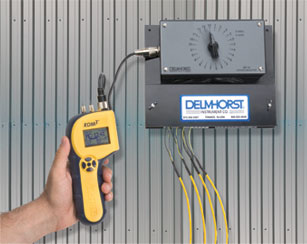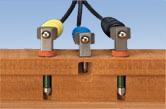 As most woodworkers know, before lumber can be used for furniture or building materials, it needs to be properly dried and acclimatized. For most lumber producers, drying out wood so that it can be used means employing a large drying kiln to heat the wood and draw out excess moisture.
As most woodworkers know, before lumber can be used for furniture or building materials, it needs to be properly dried and acclimatized. For most lumber producers, drying out wood so that it can be used means employing a large drying kiln to heat the wood and draw out excess moisture.
While experienced lumber producers will usually have a good idea of how long it will take for their lumber to dry on average, there is always the chance that a given piece of wood will not be completely dried out during the course of a normal drying cycle, or that the wood could become too dried-out.
The question is, how can woodworkers quickly check the status of their lumber while it is in the kiln?
For rapid moisture measurements, nothing beats a well-made moisture meter. The challenge is getting a reading while the kiln is still in operation. As a hot, dry environment, we would certainly recommend that you avoid entering an active kiln for your own health and safety.
Instead of walking into a hot kiln, you can install a kiln monitoring system such as Delmhorst’s KIL-MO-TROL moisture meter for in kiln monitoring which allows you to get a moisture content reading of the lumber while it is still drying.
Using an In-Kiln Monitoring System
With an in-kiln wood monitoring system, several stations are prepared at key points in your drying kiln so that you can attach moisture probes from the stations to your lumber in the kiln. Once inside the lumber, the probes stay there until you’re ready to take a reading.
Each station, in turn, has connections running to a central rotary switch box that is safely outside the kiln. To get a reading, simply plug in a compatible Delmhorst using the Delmhorst universal probe port located on many different models of moisture meters such as the RDM-3. Once connected, turn the switch to the desired position for each station and activate the meter. You’ll get a quick, reliable measurement of the moisture content of the lumber at that particular station.
Acquiring an In-Kiln Wood Monitoring System
Since not all kilns are alike, Delmhorst’s team will have a few questions to make sure that you get all of the equipment you need when you order a KIL-MO-TROL system:
-
The design, style (package or track-type), and materials of which your kiln is made. Knowing environmental factors such as the size, layout, and materials can help us make sure that your KIL-MO-TROL system is optimized for your kiln’s drying process. Also, this helps us find the optimal placement of your monitoring stations and your control box as well as establish the length of the cables that you’ll need.
-
The species and thickness of the lumber you typically dry. Different species of wood will give different moisture readings, even when they have the exact same %MC. Knowing the species of wood will help us optimize your system to give you the most accurate results. Knowing the thickness of the lumber helps to find the right length of probe to use to get both shell and core readings.
-
Board foot capacity.
Additionally, it can be helpful to include any other information you may have that is specific to your kiln’s operation or your drying process. The more information we have when you make your order, the better.
 To get the best results, it is important to be able to take both shell and core readings when measuring the moisture content of lumber drying in the kiln. For example, with only shell readings, you’re only getting the information on how dry the lumber is near the surface, and may miss moisture that is hidden deeper in the lumber. If you notice that there are inconsistencies between the outer shell and the core moisture, it may be an indication of a problem in the drying process, such as the kiln running too hot, basically baking the outer shell of the lumber before the moisture in the core has had a chance to be leeched out.
To get the best results, it is important to be able to take both shell and core readings when measuring the moisture content of lumber drying in the kiln. For example, with only shell readings, you’re only getting the information on how dry the lumber is near the surface, and may miss moisture that is hidden deeper in the lumber. If you notice that there are inconsistencies between the outer shell and the core moisture, it may be an indication of a problem in the drying process, such as the kiln running too hot, basically baking the outer shell of the lumber before the moisture in the core has had a chance to be leeched out.
This is why Delmhorst often recommends installing both smaller probes to measure moisture near the outer shell and larger, insulated probes that are designed to ensure that only the moisture content at the core is measured. This way, you can be more certain of your moisture readings.
Installing an In-Kiln Monitoring System
Once the KIL-MO-TROL is ready, installation is as easy as:
-
Mounting your rotary station selector;
-
Running the main cables out of your control room;
-
Installing pins and load cables at each station;
AND
-
Connecting the main and load cables.
If you need help with any phase of the installation process, Delmhorst’s product support team can offer detailed installation tips to help make the process easier. Kiln drying can be so much easier with a rugged, reliable in-kiln moisture monitoring system from a trusted moisture meter manufacturer.
Comments